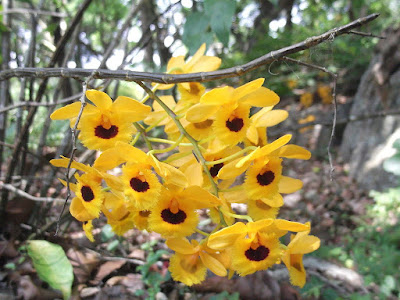Dendrobium fimbriatum is widely distributed in Southeast Asia. They are found at Hainan and southeastern China, western Himalayas, Bangladesh, eastern Himalayas, Assam India, Nepal, Bhutan, Sikkim, Myanmar, Thailand, Malaysia, Laos and Vietnam.
Dendrobium fimbriatum, also called as The Fringe-Lipped Dendrobium, Callista fimbriata, Callista normalis, Dendrobium normale, Dendrobium paxtonii, is a species of the genus Dendrobium. This species was described by William Jackson Hooker in 1823.
IDENTIFY DENDROBIUM FIMBRIATUM
Dendrobium fimbriatum is widely distributed in Southeast Asia. They are found at Hainan and southeastern China, western Himalayas, Bangladesh, eastern Himalayas, Assam India, Nepal, Bhutan, Sikkim, Myanmar, Thailand, Malaysia, Laos and Vietnam. They usually grow in humid, mossy mixed and coniferous forests at heights of 500-1520 m, but sometimes they were even at an altitude of 2400 m.
It is a large-sized, warm to cold growing epiphyte, lithophyte or terrestrial, which can reach the height of 60-120 cm, sometimes up to 180 cm, with long, erect, arching or pendulous, light-yellow green when aged, to 4' (120 cm) long stems that are thickest in the middle and have many oblong to lanceolate, acute or acuminate, deciduous, 8-15 cm long leaves.
The Fringe-Lipped Dendrobium flowers in March through May but can bloom at most any time on a pendant, axillary, 6 to 15 flowered raceme that arises from the nodes near the apex of leafless and mature canes and has sour smelling flowers. The flowers are 4.0-7.6 cm in diameter. The petals of both whorls may be pale yellow-green or deep orange-yellow. They are thin and delicate with a shiny, crystalline texture. The slightly darker lip is almost rounded, crimped and densely frayed along the edge. It is velvety and usually has a single orange or red-orange spot in the middle. The spots, however, are variable, some varieties may have 2 spots, and others may not have them at all.
DENDROBIUM FIMBRIATUM CARE AND CULTURE
Cultural information should only be used as a guide, and should be to be adapted to suit you. Your physical location; where you grow your plants, how much time you have to devote to their care, and many other factors, will need to be taken into account. Only then can you decide on the cultural methods that best suit you and your plants.
Light:
Dendrobium fimbriatum needs a light level of 25000-35000 lux.
Temperature:
The average temperature of the summer day is 27-31 ° C, night 21-22 ° C, giving a daily difference of 6-9 ° C.
Humidity:
This species needs the humidity of almost 90% in summer, but in winter it drops to 55-60%. The most dry season is spring, when humidity drops to 40% for a period of almost 2 months.
Substrate, growing media and repotting:
Dendrobium fimbriatum are best mounted on cork pads, because it corresponds to the overhanging plant habit. If these plants are grown in pots or baskets, they should be filled with any loose, airy substrate. Repotting can be performed in any period as soon as new roots grow.
Watering:
Water is moderate to heavy for 5 months of summer, Dendrobium fimbriatum should be kept moist during active growth, but when new growths mature in autumn, the amount of water should be gradually reduced.
Fertilizer:
Weekly 1/4-1/2 doses are recommended. From spring to mid-summer should be used fertilizer enriched with nitrogen, and then until the end of autumn fertilizer enriched with phosphorus.
Rest period:
A dry, cold rest period is necessary to initiate flowering. In winter, the amount of water should be limited. Dendrobium fimbriatum should be allowed to dry between waterings, but they can not stay dry for too long. Occasional morning fogging between waterings will protect the plant against excessive drying.















COMMENTS